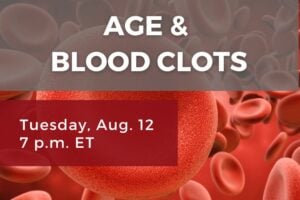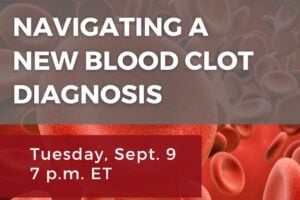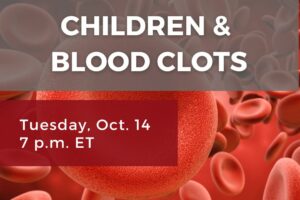Oncology Outpatients Report DVT/PE Prophylaxis Infrequently, Compared to Inpatient Survey Responses
Tarrytown, NY – June 6, 2011 — Despite being at increased risk for deep vein thrombosis (DVT) and pulmonary embolism (PE), most cancer patients are not aware of the terms DVT and PE. Compared to oncology inpatients, DVT/PE prophylaxis is utilized much less frequently among oncology outpatients, according to new survey results being unveiled by the National Blood Clot Alliance (NBCA) at the American Society of Clinical Oncology (ASCO) Annual Meeting in Chicago this week.
Data from NBCA’s DVT/PE Awareness Survey show that, among the 500 cancer patients surveyed, less than one-quarter (24%) are aware of the term DVT, and only 15% are aware of the term PE. When oncology inpatient responses are compared to those of oncology outpatients, the survey findings demonstrate that significantly more inpatients are aware of DVT and PE: Just 15% (p=<.05%) of oncology outpatients surveyed are aware of the term DVT, compared to 36% of inpatients; and, just 9% (p=<.05%) of outpatients are aware of the term PE, compared to 24% of inpatients surveyed. Similarly, significantly fewer outpatients (14%, p=<.05%), when compared to inpatients (44%), say that their doctor or another healthcare professional informed them about the risk of developing blood clots due to cancer.
DVT/PE Prophylaxis Underutilized
The NBCA DVT/PE Awareness Survey also shows that, compared to inpatient respondents, outpatients surveyed report significantly lower utilization of DVT/PE prophylaxis. About one-third of inpatient respondents report they were given warfarin (38%) and/or low molecular weight heparin (31%), compared to significantly fewer inpatient respondents who said they were given warfarin (9%, p=<.05%) and/or LMWH (6%, p=<.05%). About half of inpatients report the use of compression hose (52%) or mechanical compression (52%), compared to less than one-quarter of outpatients who report the use of compression hose (22%, p=<.05%) or mechanical compression (16%, p=<.05%). Aspirin use was reported by 39% of oncology inpatients surveyed, compared to 20% (p=<.10%) of the outpatients surveyed.
“Currently, routine DVT/PE prophylaxis is not recommended for most oncology outpatients, making the disparities seen in DVT/PE awareness and prophylaxis between oncology inpatients and outpatients in this survey consistent with the published recommendations of most expert groups,” explains Frederick R. Rickles, MD, Professor of Medicine, Pediatrics and Pharmacology and Physiology, The George Washington University, Washington, DC. “These survey data make clear, however, the need to improve or optimize DVT/PE education programs and prophylaxis practices for all patients with cancer.”
Dr. Rickles further explains that an increase in the prevalence of DVT/PE risk reduction programs, such as those mandated by the Joint Commission, and in response to the identification of DVT/PE as a “never event” by the Centers for Medicare & Medicaid Services, are likely responsible for the significantly higher reported use of DVT/PE prophylaxis reported by inpatients with cancer. According to Dr. Rickles – who is, as a member of NBCA’s DVT/PE Awareness Survey Steering Committee, presenting information about the survey findings at the ASCO Annual Meeting this week – patients with active cancer are at increased risk for DVT/PE, and the risks are greater among those who are hospitalized, undergo surgery, or receive cancer therapy.
Risk Versus Awareness and Information
Despite being at increased risk, the results of this survey further demonstrate that oncology patient awareness of DVT risk factors also is low. When asked to identify or name DVT risk factors, just 8% of all oncology patients identify surgery, and just 4% identify chemotherapy, radiation, or some form of cancer treatment as risk factors. In addition, just 86 of the total 500 oncology patients surveyed report that they can name PE signs or symptoms, with 69% of this small group citing breathing difficulty, 28% chest tightness, and 5% coughing up blood.
“NBCA conducted its DVT/PE Awareness Survey in direct response to the Surgeon General’s Call to Action to Prevent Deep Vein Thrombosis and Pulmonary Embolism,” explains NBCA Chief Executive Officer Alan P. Brownstein, MPH. “Our survey objectives were to measure DVT/PE awareness among patients with cancer and to identify gaps in DVT/PE prophylaxis reported by these patients. The survey results show the need to improve dialogue between cancer patients and their physicians about DVT/PE risk factors and prevention.”
Survey Methodology
NBCA’s DVT/PE Awareness Survey was conducted by the national survey firm USA/Direct, Inc. The oncology patient sample, screened from an online research panel, consisted of 500 adults diagnosed with cancer or recurrence of cancer within the prior 12 months (mean age 58 years; range 20-80+; 64% females), most of whom were receiving active treatment. Responses from patients who required a hospital stay for treatment (n=206) were compared to responses of patients who were exclusively treated as outpatients (n=294).
NBCA is sharing additional results of its DVT/PE Awareness Survey findings at other medical meetings in upcoming weeks and months, and through educational DVDs being made available to healthcare professionals in oncology nationwide. For more information, or to order free copies of the NBCA DVT/PE Awareness Survey DVD, contact NBCA at 877.4No.Clot (877-466-2568). NBCA is a patient-led advocacy organization dedicated to promoting patient and public awareness about the signs and symptoms of DVT and PE.
Additional Resources:
- Deep Vein Thrombosis (DVT) and Pulmonary Embolism (PE): Awareness and Prophylaxis Practices Reported by Patients with Cancer – Poster
- DVT and PE Awareness and Prophylaxis Practices Reported by Patients with Cancer – Abstact
- NBCA DVT/PE AWARENESS SURVEY FACT SHEET
- NBCA DVT/PE Survey – Orthopedics Video
The NBCA DVT/PE Awareness Survey was made possible by a grant from Ortho-McNeil™, a Division of Ortho-McNeil-Janssen Pharmaceuticals, Inc.






